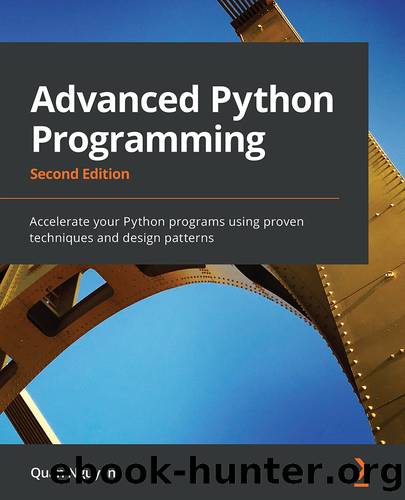Advanced Python Programming - Second Edition by Quan Nguyen

Author:Quan Nguyen
Language: eng
Format: epub
Publisher: Packt Publishing Pvt. Ltd.
Published: 2022-02-21T00:00:00+00:00
Timeout specifications
Overall, an efficient ping test application should not be waiting for responses from its websites for a long time; it should have a set threshold for a timeout that, if a server fails to return a response under that threshold, the application will deem that server non-responsive. So, we need to implement a way to keep track of how much time has passed since a request has been sent to a server. We will do this by counting down from the timeout threshold. Once that threshold has been passed, all the responses (whether they've returned yet or not) will be printed out.
Additionally, we will also be keeping track of how many requests are still pending and have not had their responses returned. We will be using the is_alive() method from the threading.Thread class to indirectly determine whether a response has been returned for a specific request. If, at one point, the thread that's processing a specific request is alive, we can conclude that that specific request is still pending.
Let's consider the following process_requests() function first:
import time
UPDATE_INTERVAL = 0.01
def process_requests(threads, timeout=5):
def alive_count():
alive = [1 if thread.is_alive() else 0 for thread
in threads]
return sum(alive)
while alive_count() > 0 and timeout > 0:
timeout -= UPDATE_INTERVAL
time.sleep(UPDATE_INTERVAL)
for thread in threads:
print(thread.result)
This function takes in a list of threads that we have been using to make web requests in the previous examples, as well as an optional argument specifying the timeout threshold. Inside this function, we have an inner function, alive_count(), which returns the count of the threads that are still alive at the time of the function call.
In the process_requests() function, so long as there are threads that are currently alive and processing requests, we will allow the threads to continue with their execution (this is done in the while loop with the double condition). The UPDATE_INTERVAL variable, as you can see, specifies how often we check for this condition. If either condition fails (if there are no alive threads left or if the threshold timeout is passed), then we will proceed with printing out the responses (even if some might have not been returned).
Let's turn our attention to the new MyThread class:
import threading
import requests
class MyThread(threading.Thread):
def __init__(self, url):
threading.Thread.__init__(self)
self.url = url
self.result = f'{self.url}: Custom timeout'
def run(self):
res = requests.get(self.url)
self.result = f'{self.url}: {res.text}'
This class is almost identical to the one we considered in the previous example, except that the initial value for the result attribute is a message indicating a timeout. In the case that we discussed earlier, where the timeout threshold specified in the process_requests() function is passed, this initial value will be used when the responses are printed out.
Finally, let's consider our main program in example6.py:
urls = [
'http://httpstat.us/200',
'http://httpstat.us/200?sleep=4000',
'http://httpstat.us/200?sleep=20000',
'http://httpstat.us/400'
]
start = time.time()
threads = [MyThread(url) for url in urls]
for thread in threads:
thread.setDaemon(True)
thread.start()
process_requests(threads)
print(f'Took {time.time() - start : .2f} seconds')
print('Done.')
Here, in our URL list, we have a request that would take 4 seconds and another that would take 20 seconds, aside from the ones that would respond immediately.
Download
This site does not store any files on its server. We only index and link to content provided by other sites. Please contact the content providers to delete copyright contents if any and email us, we'll remove relevant links or contents immediately.
Kotlin in Action by Dmitry Jemerov(17183)
Grails in Action by Glen Smith Peter Ledbrook(15389)
Sass and Compass in Action by Wynn Netherland Nathan Weizenbaum Chris Eppstein Brandon Mathis(13264)
Azure Containers Explained by Wesley Haakman & Richard Hooper(7499)
Configuring Windows Server Hybrid Advanced Services Exam Ref AZ-801 by Chris Gill(7496)
Running Windows Containers on AWS by Marcio Morales(7051)
Microsoft 365 Identity and Services Exam Guide MS-100 by Aaron Guilmette(5434)
Microsoft Cybersecurity Architect Exam Ref SC-100 by Dwayne Natwick(5272)
Combating Crime on the Dark Web by Nearchos Nearchou(5018)
The Ruby Workshop by Akshat Paul Peter Philips Dániel Szabó and Cheyne Wallace(4701)
Management Strategies for the Cloud Revolution: How Cloud Computing Is Transforming Business and Why You Can't Afford to Be Left Behind by Charles Babcock(4546)
Python for Security and Networking - Third Edition by José Manuel Ortega(4274)
The Age of Surveillance Capitalism by Shoshana Zuboff(4243)
Learn Wireshark by Lisa Bock(4175)
Learn Windows PowerShell in a Month of Lunches by Don Jones(4068)
The Ultimate Docker Container Book by Schenker Gabriel N.;(3919)
Ember.js in Action by Joachim Haagen Skeie(3660)
DevSecOps in Practice with VMware Tanzu by Parth Pandit & Robert Hardt(3608)
Windows Ransomware Detection and Protection by Marius Sandbu(3576)
